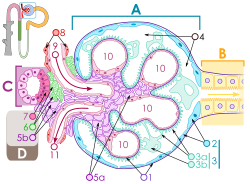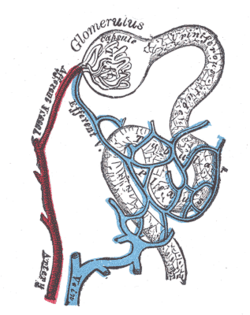Renal corpuscle
| Renal corpuscle | |
|---|---|

The structure on the left in blue and pink is the renal corpuscle. The structure on the right is the renal tubule. The blue structure (A) is the Bowman's capsule (2 and 3). The pink structure is the glomerulus with its capillaries. At the left, blood flows from the afferent areteriole (9), through the capillaries (10), and out the efferent arteriole (11). The mesangium is the pink structure inside the glomerulus between the capillaries (5a) and extending outside the glomerulus (5b).
Description
A - Renal corpuscle |
|

The renal corpuscle in the cortex (outer layer) of the kidney. At the top, the renal corpuscle containing the glomerulus. The filtered blood exits into the renal tubule, at right. At left, blood flows from the afferent arteriole (red), enters into the renal corpuscle and feeds the glomerulus; blood flows out of the efferent arteriole (blue).
|
|
| Details | |
| Identifiers | |
| Latin | corpusculum renis |
| FMA | 15625 |
|
Anatomical terminology
[]
|
|
A - Renal corpuscle
B - Proximal tubule
C - Distal convoluted tubule
D - Juxtaglomerular apparatus
1. Basement membrane (Basal lamina)
2. Bowman's capsule - parietal layer
3. Bowman's capsule - visceral layer
3a. Pedicels (podocytes)
3b. Podocyte
4. Bowman's space (urinary space)
5a. Mesangium - Intraglomerular cell
5b. Mesangium - Extraglomerular cell
6. Granular cells (Juxtaglomerular cells)
7. Macula densa
8. Myocytes (smooth muscle)
9. Afferent arteriole
10. Glomerulus Capillaries
In the kidney, a renal corpuscle is the initial blood-filtering component of a nephron. It consists of two structures: a glomerulus and a Bowman's capsule.
The glomerulus is a small tuft of capillaries containing two cell types. Endothelial cells, which have large fenestrae, are not covered by diaphragms. Mesangial cells are modified smooth muscle cells that lie between the capillaries. They regulate blood flow by their contractile activity and secrete extracellular matrix, prostaglandins, and cytokines. Mesangial cells also have phagocytic activity, removing proteins and other molecules trapped in the glomerular basement membrane or filtration barrier.
The Bowman's capsule has an outer parietal layer composed of simple squamous epithelium. The visceral layer, composed of modified simple squamous epithelium, is lined by podocytes. Podocytes have foot processes, pedicels, that wrap around glomerular capillaries. These pedicels interdigitate with pedicels of adjacent podocytes forming filtration slits.
The renal corpuscle filtration barrier is composed of: the fenestrated endothelium of glomerular capillaries, the fused basal lamina of endothelial cells and podocytes, and the filtration slits of the podocytes. This barrier permits passage of water, ions, and small molecules from the bloodstream into Bowman's space (the space between the visceral and parietal layers). Large and/or negatively charged proteins are prevented from passing into Bowman's space, thus retaining these proteins in the circulation. The basal lamina is composed of 3 layers: lamina rara externa, lamina densa, and lamina rara interna. The lamina rara externa is adjacent to the podocyte processes. The lamina densa is the central layer consisting of type IV collagen and laminin. This layer acts as a selective macromolecular filter, preventing the passage of large protein molecules into Bowman's space. The lamina rara interna is adjacent to endothelial cells. This layer contains heparan sulfate, a negatively charged glycosaminoglycan that contributes to the electrostatic barrier of the glomerular filter.
...
Wikipedia
